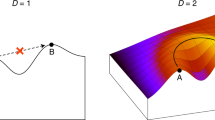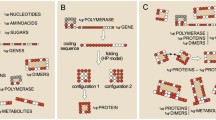Abstract
The current implementation of the Neo-Darwinian model of evolution typically assumes that the set of possible phenotypes is organized into a highly symmetric and regular space. Most conveniently, a Euclidean vector space is used, representing phenotypic properties by real-valued variables. Computational work on the biophysical genotype-phenotype model of RNA folding, however, suggests a rather different picture. If phenotypes are organized according to genetic accessibility, the resulting space lacks a metric and can be formalized only in terms of a relatively unfamiliar structure. Patterns of phenotypic evolution—such as punctuation, irreversibility, and modularity—result naturally from the properties of the genotype-phenotype map, which, given the genetic accessibility structure, define accessibility in the phenotype space. The classical framework, however, addresses these patterns exclusively in terms of natural selection on suitably constructed fitness landscapes. Recent work has extended the explanatory level for phenotypic evolution from fitness considerations alone to include the topological structure of phenotype space as induced by the genotype-phenotype map. Lewontin’s notion of “quasi-independence” of characters can also be formalized in topological terms: it corresponds to the assumption that a region of the phenotype space is represented by a product space of orthogonal factors. In this picture, each character corresponds to a factor of a region of the phenotype space. We consider any region of the phenotype space that has a given factorization as a “type”, i.e., as a set of phenotypes that share the same set of phenotypic characters. Thus, a theory of character identity can be developed that is based on the correspondence of local factors in different regions of the phenotype space.
Similar content being viewed by others
References
Alexandroff P (1937) Diskrete Räume, Mathematica Sbornik (N.S.) 2: 501–518.
Ancel L, Fontana W (2000) Plasticity, evolvability and modularity in RNA. Journal of Experimental Zoology (Molecular and Developmental Evolution) 288: 242–283.
Arenas FG (1999) Alexandroff spaces. Acta Mathematica Universitatis Comenianae 68: 17–25.
Babajide A, Farber R, Hofacker IL, Inman J, Lapedes AS, Stadler PF (2001) Exploring protein sequence space using knowledge based potentials. Journal of Theoretical Biology 212: 35–46.
Babajide A, Hofacker IL, Sippl MJ, Stadler PF (1997) Neutral networks in protein space: A computational study based on knowledge-based potentials of mean force. Folding and Design 2: 261–269.
Biebricher CK, Gardiner WC (1997) Molecular evolution of RNA in vitro. Biophysical Chemistry 66: 179–192.
Brinn LW (1985) Computing topologies. Mathematical Journal 58: 67–77.
Calude C, Căzănescu VE (1979) On topologies generated by Mosil resemblance relations. Discrete Mathematics 25: 109–115.
Čech E (1966) Topological Spaces. London: Wiley.
Changat M, Klavžar S, Mulder HM (2001) The all-path transit function of a graph. Czechoslovak Mathematical Journal 51: 439–148.
Cupal J, Kopp S, Stadler PF (2000) RNA shape space topology. Artificial Life 6: 3–23.
Dalal S, Balasubramanian S, Regan L (1997) Protein alchemy: Changing β-sheet into α-helix. Nature Structural and Molecular Biology 4(7): 548–552.
Derrida B, Peliti L (1991) Evolution in a flat fitness landscape. Bulletin of Mathematical Biology 53: 355–382.
Dörfler W, Imrich W (1970) Über das starke Produkt von endlichen Graphen. Österreichische Akademie der Wissenschaften, Mathematischnaturwissenschaftliche Klasse S.-B. II 178: 247–262.
Eigen M, McCaskill J, Schuster P (1989) The molecular quasispecies. Advances in Chemical Physics 75: 149–263.
Feigenbaum J, Schäffer AA (1992) Finding the prime factors of strong direct products of graphs in polynomial time. Discrete Mathematics 109: 77–102.
Flamm C, Hofacker IL, Stadler PF (1999) RNA in silico: The computational biology of RNA secondary structures. Advances in Complex Systems 2: 65–90.
Fontana W, Schuster P (1998a) Continuity in evolution: On the nature of transitions. Science 280: 1451–1455.
Fontana W, Schuster P (1998b) Shaping space: The possible and the attainable in RNA genotype-phenotype mapping. Journal of Theoretical Biology 194: 491–515.
Gavrilets S (1997) Evolution and speciation on holey adaptive landscapes. Trends in Ecology and Evolution 12: 307–312.
Gitchoff P, Wagner GP (1996) Recombination induced hypergraphs: A new approach to mutation-recombination isomorphism. Complexity 2: 37–43.
Gnilka S (1994) On extended topologies. I. Closure operators. Annales de la Societe Polonaise de Mathematique, Seria I, Commentations Mathematical 34: 81–94.
Gnilka S (1997) On continuity in extended topologies. Annales de la Societé Polonaise de Mathematique., Seria I, Commentations Mathematical 37: 99–108.
Grüner W, Giegerich R, Strothmann D, Reidys C, Weber J, Hofacker IL, Stadler PF, Schuster P (1996a) Analysis of RNA sequence structure maps by exhaustive enumeration. I. Neutral networks. Monatshefte für Chemie 127: 355–374.
Grüner W, Giegerich R, Strothmann D, Reidys C, Weber J, Hofacker IL, Stadler PF, Schuster P (1996b) Analysis of RNA sequence structure maps by exhaustive enumeration. II. Structures of neutral networks and shape space covering. Monatshefte für Chemie 127: 375–389.
Hofacker IL, Fontana W, Stadler PF, Bonhoeffer LS, Tacker M, Schuster P (1994) Fast folding and comparison of RNA secondary structures. Monatshefte für Chemie 125: 167–188.
Hofacker IL, Schuster P, Stadler PF (1998) Combinatorics of RNA secondary structures. Discrete Applied Mathematics 89: 177–207.
Huynen MA (1996) Exploring phenotype space through neutral evolution. Journal of Molecular Evolution 43: 165–169.
Huynen MA, Stadler PF, Fontana W (1996) Smoothness within ruggedness: The role of neutrality in adaptation. Proceedings of the National Academy of Sciences (The USA) 93: 397–401.
Imrich W (1998) Factoring cardinal product graphs in polynomial time. Discrete Mathematics 192: 119–144.
Imrich W, Klavžar S (2000) Product Graphs: Structure and Recognition. New York: Wiley.
Imrich W, Stadler PF (2006) A prime factor theorem for a generalized direct product. Discussiones Mathematicae Graph Theory 26: 135–140.
Keefe AD, Szostak JW (2001) Functional proteins from a random-sequence library. Nature 410: 715–718.
Kent DC (1967) On convergence groups and convergence uniformities. Fun-damenta Mathematicae 60: 213–222.
Lewontin RC (1978) Adaptation. Scientific American 239: 156–169.
Liu YM, Luo MK (1998) Fuzzy Topology. Singapore: World Scientific.
Lovász L (1967) Operations with structures. Acta Mathematica Academiae Scientiarum Hungaricae 18: 321–328.
Lovasz L (1971) Unique factorization in certain classes of structures. In: Mini-Conf. Univers. Algebra, Szeged 1971 24–25. János Bolyai Mathematical Society.
Malitza M (1975) Topology, binary relations, and internal operations. Revue Roumaine de Mathematiques Pures et Appliquees 4: 515–519.
Martinez MA, Pezo V, Marlière P, Wain-Hobson S (1996) Exploring the functional robustness of an enzyme by in vitro evolution. EMBO Journal 15: 1203–1210.
Mathews D, Sabina J, Zuker M, Turner H (1999) Expanded sequence dependence of thermodynamic parameters provides robust prediction of RNA secondary structure. Journal of Molecular Biology 288: 911–940.
Maynard-Smith J (1970) Natural selection and the concept of a protein space. Nature 225: 563–564.
McKenzie R (1971) Cardinal multiplication of structures with a reflexive multiplication. Fundamenta Mathematicae 70: 59–101.
Menger K (1942) Statistical metrics. Proceedings of the National Academy of Sciences USA 28: 535–537.
Morgana MA, Mulder HM (2002) The induced path convexity, betweenness, and svelte graphs. Discrete Mathematics 254: 349–370.
Reidys C, Stadler PF, Schuster P (1997) Generic properties of combinatory maps. Neutral networks of RNA secondary structure. Bulletin of Mathematical Biology 59: 339–397.
Reidys CM (1997) Random induced subgraphs of generalized n-cubes. Advances in Applied Mathematics 19: 360–377.
Richardson G, Kent D (1996) Probabilistic convergence spaces. Journal of the Australian Mathematical Society (Series A) 61: 1–21.
Sanin N (1943) On separation in topological space. Doklady Akademii Nauk SSSR 38: 110–113.
Schultes EA, Bartel DP (2000) One sequence, two ribozymes: Implications for the emergence of new ribozyme folds. Science 289: 448–452.
Schuster P (1997) Genotypes with phenotypes: Adventures in an RNA toy world. Biophysical Chemistry 66: 75–110.
Schuster P (2001) Evolution in Silico and in Vitro: The RNA model. Biological Chemistry 382: 1301–1314.
Schuster P (2002) A testable genotype-phenotype map: Modeling evolution of RNA molecules. In: Biological Evolution and Statistical Physics (Lässig M, Valleriani A, eds), 56–83. Berlin: Springer-Verlag.
Schuster P, Fontana W, Stadler PF, Hofacker IL (1994) From sequences to shapes and back: A case study in RNA secondary structures. Proceedings of the Royal Society London B 255: 279–284.
Schuster P, Stadler PF, Renner A (1997) RNA structure and folding. From conventional to new issues in structure predictions. Current Opinion in Structural Biology 7: 229–235.
Schweizer B, Sklar A (1983) Probabilistic Metric Spaces. New York: North Holland.
Shpak M, Wagner GP (2000) Asymmetry of configuration space induced by unequal crossover: implications for a mathematical theory of evolutionary innovation. Artificial Life 6: 25–43.
Sippl MJ (1993) Boltzmann’s principle, knowledge-based mean fields and protein folding: An approach to the computational determination of protein structures. Journal of Computer-Aided Molecular Design 7: 473–501.
Slapal J (1993) Relations and topologies. Czechoslovak Mathematical Journal 43: 141–150.
Stadler BMR (2002) Diffusion of a population of interacting replicators in sequence space. Advances in Complex Systems 5: 457–461.
Stadler BMR, Stadler PF (2002) Generalized topological spaces in evolutionary theory and combinatorial chemistry. Journal of Chemical Information and Computer Sciences 42: 577–585.
Stadler BMR, Stadler PF (2004) The topology of evolutionary biology. In: Modeling in Molecular Biology (Ciobanu G, ed), Natural Computing Series 267–286. New York: Springer Verlag.
Stadler BMR, Stadler PF, Shpak M, Wagner GP (2002) Recombination spaces, metrics, and pretopologies. Zeitschrift für Physikalische Chemie 216: 217–234.
Stadler BMR, Stadler PF, Wagner G, Fontana W (2001) The topology of the possible: Formal spaces underlying patterns of evolutionary change. Journal of Theoretical Biology 213: 241–274.
Stadler PF, Seitz R, Wagner GP (2000) Evolvability of complex characters: Population dependent Fourier decomposition of fitness landscapes over recombination spaces. Bulletin of Mathematical Biology 62: 399–428.
Stadler PF, Wagner GP (1998) The algebraic theory of recombination spaces. Evolutionary Computation 5: 241–275.
Stephan-Otto Attolini C, Stadler PF (2005) Neutral networks of interacting RNA secondary structures. Advances in Complex Systems 8: 275–284.
Stephan-Otto Attolini C, Stadler PF (2006) Evolving towards the hypercycle: A spatial model of molecular evolution. Physica D 217: 134–141.
Wagner G, Stadler PF (2003) Quasi-independence, homology and the unity of type: A topological theory of characters. Journal of Theoretical Biology 220: 505–527.
Weberndorfer G, Hofacker IL, Stadler PF (1999) An efficient potential forprotein sequence design. In: Computer Science in Biology 107–112. Bielefeld, D: Univ. Bielefeld Proceedings of the GCB’99, Hannover, D.
Wilson DS, Szostak JW (1999) In Vitro selection of functional nucleic acids. Annual Review of Biochemistry 68: 611–647.
Wright S (1932) The roles of mutation, inbreeding, crossbreeeding and selection in evolution. In: Proceedings of the Sixth International Congress on Genetics, vol. 1 (Jones DF, ed), 356–366.
Wright S (1967) “Surfaces” of selective value. Proceedings of the National Academy of Sciences (The USA) 58: 165–172.
Zuker M, Sankoff D (1984) RNA secondary structures and their prediction. Bulletin of Mathematical Biology 46(4): 591–621.
Author information
Authors and Affiliations
Corresponding author
Electronic supplementary material
Rights and permissions
About this article
Cite this article
Stadler, P.F., Stadler, B.M.R. Genotype-Phenotype Maps. Biol Theory 1, 268–279 (2006). https://doi.org/10.1162/biot.2006.1.3.268
Received:
Accepted:
Published:
Issue Date:
DOI: https://doi.org/10.1162/biot.2006.1.3.268




